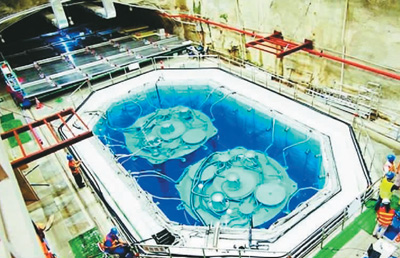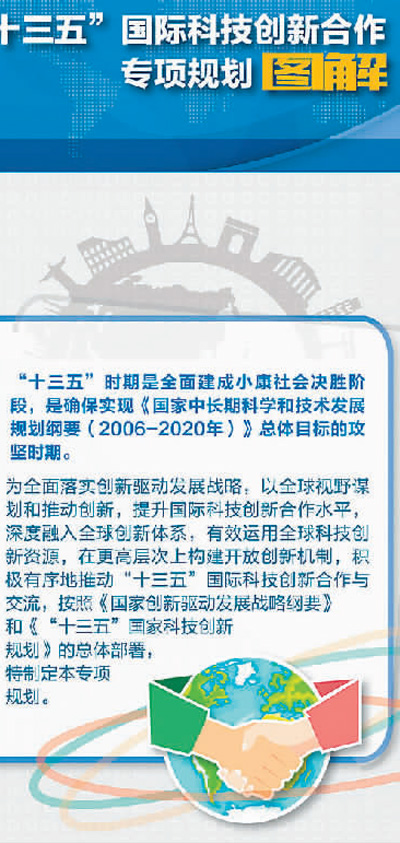
The neutrino experiment project of Daya Bay nuclear reactor was led by scientists from China, and about 40 institutions from seven countries and regions participated in it. The picture shows the relevant experimental equipment.


Recently, the experimental device designed by China arrived at the International Space Station with the Falcon 9 rocket. With the help of commercial cooperation mode, Chinese researchers successfully bypassed the "Wolf Clause" and joined hands with their American counterparts to explore space. At the 2017 Global Space Exploration Conference, it was reported that China Chang ‘e IV, which is scheduled to be launched in 2018, will fly to the moon with scientific loads from four countries, including the Netherlands and Germany, for scientific exploration.
All these show that in the era of "global village" in which globalization is surging, China scientists conform to the development trend, actively participate in and vigorously promote international scientific and technological cooperation, and work together with international scientific and technological counterparts to make their own contributions to promoting their understanding of the world.
"Big Science" Cooperation as the Guide
Since you are involved, you should make greater contributions and play a greater role as much as possible. This is the principle that China has always adhered to in international scientific and technological cooperation and exchange. It’s not easy to do this, but scientists in China have found sufficient confidence from their practice in recent years. They have not only completed their own tasks, but also played a leading role in organizing some major international scientific projects.
In April this year, the international cooperation project on human phenotypic research (one of the major international scientific projects, which is thought to crack the code of human birth, illness and death) entered the final stage before it was fully launched. The project was presided over by China scholars such as Academician of Chinese Academy of Sciences and Professor Jin Li, Vice President of Fudan University, with the participation of hundreds of global scientists. Previously, scientists from China have taken the lead in participating in some major international science projects. For example, the neutrino experiment in Daya Bay nuclear reactor stood out from eight experimental schemes around the world, and formed an international cooperative research team led by Wang Yifang, director of Institute of High Energy Physics of Chinese Academy of Sciences, and composed of 40 institutions from seven countries and regions around the world. In March 2012, the experimental team announced the discovery of a new neutrino oscillation, which won high recognition from the international physics community. Robert mckee Weng, a well-known American scientist, believes that this discovery can be said to be the most important physical (experimental) result from China.
Known as "Artificial Sun", ITER is the largest international scientific and technological cooperation program in which China participates as an equal and full-fledged partner. Institute of Plasma Physics, Hefei Research Institute, Chinese Academy of Sciences is one of the important units of the China Working Group participating in this project. According to Wu Yu, director of the Applied Superconducting Engineering Technology Research Office of the Institute, most of the projects undertaken by China in this cooperation plan are related to superconductivity and power supply. At present, the large-scale superconducting conductor technology and quality system independently developed by China have passed the evaluation of international organizations, and the delivery of large-scale products has been completed for the first time in ITER plan, with 100% localization and 100% qualification rate. While participating in ITER construction, China scientists have begun to plan and build the future China nuclear fusion engineering experimental reactor. According to reports, the overall design scheme of the experimental reactor has been completed, and the pre-research work is currently being carried out. It can be predicted that China scientists will play a greater role and make more outstanding contributions in the international grand scientific plan of peaceful use of nuclear energy for human controlled nuclear fusion.
Develop "step by step" in three periods.
International cooperation and exchange is an inevitable requirement of opening up to the outside world in the field of science and technology. Under the background of globalization, the links between countries are getting closer and closer, and the importance of international cooperation and exchange in science and technology is becoming increasingly prominent. As Xu Guanhua, former Minister of Science and Technology, once pointed out, the motive force of scientific and technological development lies in the collision of different ideas and cultures. Through extensive and in-depth international exchanges and cooperation, fully absorb the wisdom and technological advantages of others, which is in line with the inherent requirements of the development of science and technology itself. In the new historical period, independent innovation should be based on the strategic idea of constantly expanding and strengthening international scientific and technological cooperation and making full use of global scientific and technological resources.
Based on the analysis of researcher Cheng Ruyan of China Institute of Science and Technology Information, we can generally divide the development of international cooperation and exchange of science and technology in China into three periods since the reform and opening up.
The first is the recovery period (1978-1985). The National Science Conference held in March, 1978 proposed "strengthening international scientific and technological cooperation and exchange", "inviting foreign scientists and engineering experts to give lectures in China" and "strengthening the scientific and technological research work of our overseas institutions". During this period, China determined the specific policy of international scientific and technological cooperation at this stage, adjusted the centralized management of scientific and technological foreign affairs, established the management system of talent introduction, and strengthened the scientific and technological research of foreign institutions.
The second is the period of all-round development (1985-2000). 《1986— The Science and Technology Development Plan 2000 puts forward policies and measures to further strengthen international science and technology cooperation and technology introduction, and points out that it is necessary to further organize and formulate unified technology introduction policies and plans. During this period, the international science and technology cooperation policy further strengthened and standardized the technology introduction work; Strengthen the guidance and management of joint research and development institutions; Made a decision to actively join international science and technology organizations; Standardize the protection of intellectual property rights in international scientific and technological cooperation and exchanges.
The third is the period of great leap (from 2000 to present). China has established the policy of "mutual benefit and win-win" and carried out international scientific and technological cooperation in an all-round, multi-level and wide-ranging way. During this period, the international science and technology cooperation policy showed four characteristics: promoting international science and technology cooperation from the national strategic level; Strengthen international scientific and technological cooperation and set up special funds for international scientific and technological cooperation; Actively participate in and take the lead in organizing the international big science and big project plan; Strengthen technical assistance to developing countries.
The government and the people set each other off.
According to Ye Dongbai, director of the Department of International Cooperation of the Ministry of Science and Technology, China’s international cooperation and exchange in science and technology has made great achievements in the past 40 years since the reform and opening up. He listed a series of relevant statistics. Up to now, China has scientific and technological cooperation relations with about 160 countries and regions, has signed more than 110 intergovernmental scientific and technological cooperation agreements, joined more than 200 intergovernmental international scientific and technological cooperation organizations, and sent about 150 scientific and technological diplomats to more than 70 foreign embassies and consulates around the world. China has opened nine innovative dialogue mechanisms with major countries and regions in the world (China-US, Central Europe, China-Germany, China-France, China-Israel, China-Pakistan (West), China-Russia, China-Canada, China and Belgium), and established six scientific and technological partnership programs with developing countries (China Africa, China ASEAN, China South Asia, SCO countries, Latin American countries and Arab countries), which basically achieved global coverage for developing countries.
Ye Dongbai pointed out that China’s international scientific and technological cooperation and exchanges are unprecedentedly active. On the international stage, we have shown a positive and enterprising spirit and put forward new ideas, initiatives and plans for cooperation and exchanges. Committed to creating a new pattern of paying equal attention to "bringing in" and "going out" in international scientific and technological exchanges. With regard to the related work promoted this year, Ye Dongbai said that China will formulate country-specific cooperation strategies with Britain, Italy, Israel and other countries on the basis of the experience of publishing the German Strategy for Building the Future through Science and Technology Innovation in 2016. According to the plan, China-EU scientific and technological innovation cooperation will usher in several important activities, including the third China-EU innovation cooperation dialogue, the second China-France innovation dialogue, the deep docking between China and German Industry 4.0, and the docking cooperation between China High-tech Zone and Italian industrial clusters.
While actively exploring and utilizing the traditional international scientific and technological cooperation and exchange platform, China is also building and building a new platform. The "One Belt, One Road" of "openness, tolerance, cooperation, co-construction and sharing" is undoubtedly one of the best platforms to benefit the scientific and technological innovation of countries along the route. At the summit forum on "One Belt, One Road" international cooperation held in mid-May, China announced the launch of the "One Belt, One Road" scientific and technological innovation action plan, and carried out four actions: scientific and technological humanities exchange, joint laboratory construction, cooperation in science and technology parks and technology transfer. It promises to arrange 2,500 young scientists to engage in short-term scientific research in China in the next five years, train 5,000 scientific, technical and managerial personnel, and put 50 joint laboratories into operation. Advocate countries along the route to strengthen cooperation in frontier areas such as digital economy and artificial intelligence, and promote the construction of big data, cloud computing and smart cities.
Promoting non-governmental scientific and technological cooperation and exchanges between China and foreign countries is an important dimension of China’s scientific and technological opening up. China Association for Science and Technology, as a mass organization of scientific and technical workers in China, has intensified its efforts in recent years to support and help China scientists to participate in international scientific and technological organizations and hold posts, and to support and encourage the Society to hold a series of meetings of high-level international organizations in China. At the level of various enterprises, a large number of Chinese and foreign scientific and technological workers have gone abroad and realized transnational flow, which not only deepened cultural exchanges, but also promoted innovation and entrepreneurship.